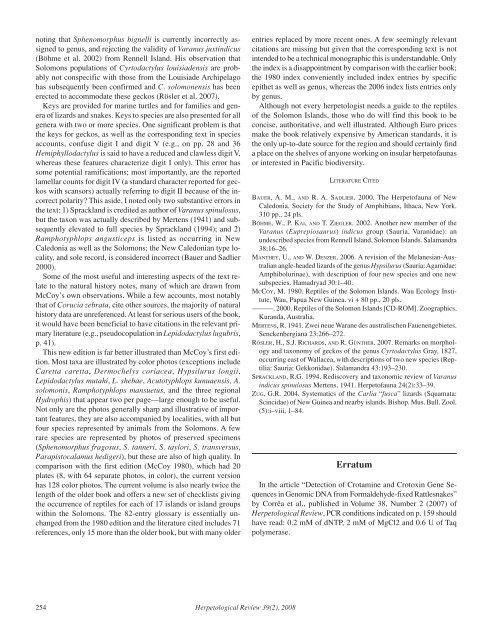Herpetological Review Herpetological Review - Doczine
Herpetological Review Herpetological Review - Doczine
Herpetological Review Herpetological Review - Doczine
You also want an ePaper? Increase the reach of your titles
YUMPU automatically turns print PDFs into web optimized ePapers that Google loves.
noting that Sphenomorphus bignelli is currently incorrectly assignedto genus, and rejecting the validity of Varanus juxtindicus(Böhme et al. 2002) from Rennell Island. His observation thatSolomons populations of Cyrtodactylus louisiadensis are probablynot conspecific with those from the Louisiade Archipelagohas subsequently been confirmed and C. solomonensis has beenerected to accommodate these geckos (Rösler et al. 2007).Keys are provided for marine turtles and for families and generaof lizards and snakes. Keys to species are also presented for allgenera with two or more species. One significant problem is thatthe keys for geckos, as well as the corresponding text in speciesaccounts, confuse digit I and digit V (e.g., on pp. 28 and 36Hemiphyllodactylus is said to have a reduced and clawless digit V,whereas these features characterize digit I only). This error hassome potential ramifications; most importantly, are the reportedlamellar counts for digit IV (a standard character reported for geckoswith scansors) actually referring to digit II because of the incorrectpolarity? This aside, I noted only two substantive errors inthe text: 1) Sprackland is credited as author of Varanus spinulosus,but the taxon was actually described by Mertens (1941) and subsequentlyelevated to full species by Sprackland (1994); and 2)Ramphotyphlops angusticeps is listed as occurring in NewCaledonia as well as the Solomons; the New Caledonian type locality,and sole record, is considered incorrect (Bauer and Sadlier2000).Some of the most useful and interesting aspects of the text relateto the natural history notes, many of which are drawn fromMcCoy’s own observations. While a few accounts, most notablythat of Corucia zebrata, cite other sources, the majority of naturalhistory data are unreferenced. At least for serious users of the book,it would have been beneficial to have citations in the relevant primaryliterature (e.g., pseudocopulation in Lepidodactylus lugubris,p. 41).This new edition is far better illustrated than McCoy’s first edition.Most taxa are illustrated by color photos (exceptions includeCaretta caretta, Dermochelys coriacea, Hypsilurus longii,Lepidodactylus mutahi, L. shebae, Acutotyphlops kunuaensis, A.solomonis, Ramphotyphlops mansuetus, and the three regionalHydrophis) that appear two per page—large enough to be useful.Not only are the photos generally sharp and illustrative of importantfeatures, they are also accompanied by localities, with all butfour species represented by animals from the Solomons. A fewrare species are represented by photos of preserved specimens(Sphenomorphus fragosus, S. tanneri, S. taylori, S. transversus,Parapistocalamus hedigeri), but these are also of high quality. Incomparison with the first edition (McCoy 1980), which had 20plates (8, with 64 separate photos, in color), the current versionhas 128 color photos. The current volume is also nearly twice thelength of the older book and offers a new set of checklists givingthe occurrence of reptiles for each of 17 islands or island groupswithin the Solomons. The 82-entry glossary is essentially unchangedfrom the 1980 edition and the literature cited includes 71references, only 15 more than the older book, but with many olderentries replaced by more recent ones. A few seemingly relevantcitations are missing but given that the corresponding text is notintended to be a technical monographic this is understandable. Onlythe index is a disappointment by comparison with the earlier book;the 1980 index conveniently included index entries by specificepithet as well as genus, whereas the 2006 index lists entries onlyby genus.Although not every herpetologist needs a guide to the reptilesof the Solomon Islands, those who do will find this book to beconcise, authoritative, and well illustrated. Although Euro pricesmake the book relatively expensive by American standards, it isthe only up-to-date source for the region and should certainly finda place on the shelves of anyone working on insular herpetofaunasor interested in Pacific biodiversity.LITERATURE CITEDBAUER, A. M., AND R. A. SADLIER. 2000. The Herpetofauna of NewCaledonia. Society for the Study of Amphibians, Ithaca, New York.310 pp., 24 pls.BÖHME, W., P. KAI, AND T. ZIEGLER. 2002. Another new member of theVaranus (Euprepiosaurus) indicus group (Sauria, Varanidae): anundescribed species from Rennell Island, Solomon Islands. Salamandra38:16–26.MANTHEY, U., AND W. DENZER. 2006. A revision of the Melanesian-Australianangle-headed lizards of the genus Hypsilurus (Sauria: Agamidae:Amphibolurinae), with description of four new species and one newsubspecies. Hamadryad 30:1–40.MCCOY, M. 1980. Reptiles of the Solomon Islands. Wau Ecology Institute,Wau, Papua New Guinea. vi + 80 pp., 20 pls.––––––. 2000. Reptiles of the Solomon Islands [CD-ROM]. Zoographics,Kuranda, Australia.MERTENS, R. 1941. Zwei neue Warane des australischen Fauenengebietes.Senckenbergiana 23:266–272.RÖSLER, H., S.J. RICHARDS, AND R. GÜNTHER. 2007. Remarks on morphologyand taxonomy of geckos of the genus Cyrtodactylus Gray, 1827,occurring east of Wallacea, with descriptions of two new species (Reptilia:Sauria: Gekkonidae). Salamandra 43:193–230.SPRACKLAND, R.G. 1994. Rediscovery and taxonomic review of Varanusindicus spinulosus Mertens, 1941. Herpetofauna 24(2):33–39.ZUG, G.R. 2004. Systematics of the Carlia “fusca” lizards (Squamata:Scincidae) of New Guinea and nearby islands. Bishop. Mus. Bull. Zool.(5):i–viii, 1–84.ErratumIn the article “Detection of Crotamine and Crotoxin Gene Sequencesin Genomic DNA from Formaldehyde-fixed Rattlesnakes”by Corrêa et al., published in Volume 38, Number 2 (2007) of<strong>Herpetological</strong> <strong>Review</strong>, PCR conditions indicated on p. 159 shouldhave read: 0.2 mM of dNTP, 2 mM of MgCl2 and 0.6 U of Taqpolymerase.254 <strong>Herpetological</strong> <strong>Review</strong> 39(2), 2008














